Fix: iPhone not recognized by Windows 10
iPhones have no doubt come a long way since their first release. Latest iPhones like iPhone 8, 8 Plus and iPhone X comes with a ton of features that makes life a lot easier. Since these iPhone are a part of our daily lives, there is a lot of media and other documents saved in these devices. A lot of the times, you would prefer to have this data on your computer as well. Usually, you will simply connect your iPhone to your computer and transfer the required files. But, sometimes, you might see that your computer isn’t recognizing your device. There are cases where your iTunes won’t even recognize your device as well. There are multiple variations of this case. For example, your iTunes might be recognizing your iPhone but your computer might not or vice versa. In worst cases, both the iTunes and your computer might not recognize your device.
This problem of iPhone not getting recognized can be caused by a couple of things. This first and foremost is the outdated or corrupted iTunes. The problem can also be caused by faulty drivers. Drivers of the services/applications related to iPhone might be outdated or corrupted. So, as you can see, the issue is can easily be rectified with updating your drivers and applications.
So, here are a few methods that will guide you through the process of solving the main issue.
Tips
As usual, we would like to give you some small tips and tricks that might help you solve the issue or at least narrow down the cause.
- Make sure your Windows is updated. If not, install all the latest Windows Updates.
- Restart all the devices that are involved in the process. This includes your computer and iPhone.
- Get rid of the USB-hub and connect your iPhone directly to the computer port
- Check if your iPhone is turned on. It needs to be turned on
- When you connect your iPhone to your computer, you will see a prompt on your iPhone asking you about whether you trust the computer or not. Make sure you selected the “Trust” option
- Check your USB cable thoroughly. Make sure that your USB cable isn’t broken. Also, check if it is connected to a working port and connected properly. Sometimes the issue is just lose connection.
- Make sure your iTunes is updated to the latest version. Simply start iTunes, go to Help and select Check for Updates
- Make sure your iPhone is unlocked i.e. you can see the home screen and apps. Sometimes your iPhone won’t be recognized in lock condition.
- Make sure there aren’t any third party applications conflicting issues. It’s usually advised to turn off your antivirus for a small period of time. Antiviruses comes with a disable option. So, disable your antivirus and then check.
Method 1: Uninstall and Reinstall iTunes
The first thing that you should do is, of course, reinstall your iTunes. Since iTunes isn’t recognizing your iPhone, the troubleshooting should start with the iTunes. Your device might not be getting recognized because of an outdated or corrupted application.
Keep in mind that this isn’t just updating the iTunes. We will first uninstall iTunes and then reinstall it on the computer. So, first have a look at how to uninstall iTunes
Uninstall
- Hold Windows key and press R
- Type appwiz.cpl and press Enter
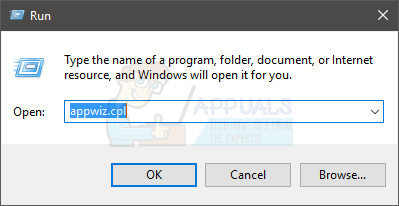
- Locate and select iTunes
- Click Uninstall and follow any additional prompts

- Now, locate and select Bonjour
- Click Uninstall and follow and additional prompts

Once done, your iTunes should be completely uninstalled from the computer
Reinstall
- Go here and click on the Download Even if you already have the installer, download the setup from their official website just to make sure that you are installing the latest version
- Once downloaded, run the downloaded file and install iTunes
Once installed, connect your iPhone again and check if the problem is solved or not.
Method 2: Check Apple Mobile Device USB Driver
Apple Mobile Device USB Driver plays a vital role in recognizing your iPhone. Your computer won’t recognize your iPhone if Apple Mobile Device USB Driver is missing or corrupted or outdated or disabled. In short, your Apple Mobile Device USB Driver should be in working condition.
So, if your iPhone isn’t getting recognized, checking Apple Mobile Device USB Driver is a logical option.
Enable Apple Mobile Device USB Driver
- Hold Windows key and press R
- Type devmgmt.msc and press Enter
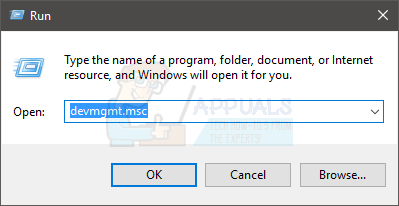
- Locate and double click Universal Serial Bus controllers
- Right click Apple Mobile Device USB Driver and select Enable. If you see a Disable option then that means this device is already enabled. In this case, click Disable and then select Enable This will restart the device.
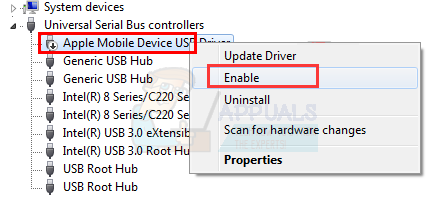
Note: If you don’t see an Apple Mobile Device USB Driver in step 4 then disconnect your device and make sure it is connected properly. Apple Mobile Device USB Driver should appear in the Device Manager as soon as your iPhone connects to the computer. If you don’t see any Apple Mobile Device USB Driver then that means there is a problem in the connection. So, check the connection, try a different port and make sure the USB cable is working. Try to connect your iPhone on another computer. If your iPhone isn’t getting recognized on any computer then contact customer support.
Restart Apple Mobile Device USB Driver Service
If enabling Apple Mobile Device USB Driver from the Device Manager didn’t solve the issue then it’s time to restart the Apple Mobile Device USB Driver service.
- Hold Windows key and press R
- Type devmgmt.msc and press Enter
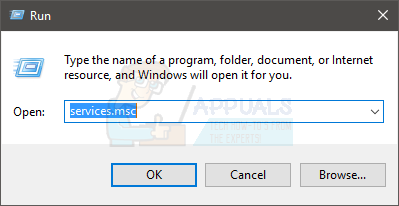
- Locate and double click Apple Mobile Device USB Driver
- Click Stop (if the service status is running). Once the service is stopped, click Start to start the service again.
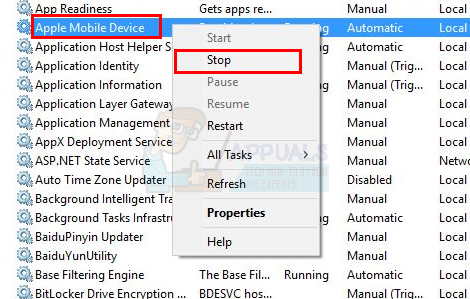
- Click Ok
Check if the iPhone is getting recognized now. If it isn’t, then continue.
Reinstall Apple Mobile Device USB Driver
If the enabling and restating Apple Mobile Device USB Driver didn’t work then its time to completely reinstall Apple Mobile Device USB Driver.
Note: Make sure your iTunes is closed.
- Connect your iPhone to the computer. Make sure it is unlocked.
- Hold Windows key and press R
- Type devmgmt.msc and press Enter
- Locate and double click Universal Serial Bus controllers
- Right click Apple Mobile Device USB Driver and select Update Driver Software…
- Select Browse my computer for driver software
- Select Let me pick from a list of device drivers on my computer
- Click Have Disk…
- Select Browse
- Navigate to this address C:\Program Files\Common Files\Apple\Mobile Device Support
- Double click Drivers folder
- Select usbaapl64 file. Note: If you don’t see this file then navigate to C:\Program Files(x86)\Common Files\Apple\Mobile Device Support, double click Drivers folder and select usbaapl
- Click Open and then select Ok
- Click Next
Now, wait for the Windows to install the Apple Mobile Device USB Driver. Once the process is complete, unplug your iPhone and reboot. Your problem should be solved once the reboot completes.